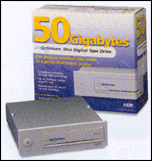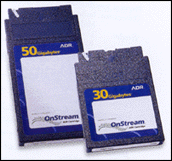
Original Link: https://www.anandtech.com/show/330
Introduction
Today, storage requirements are getting quite large. Most large office applications are taking upwards of 400MB after a full-blown install. After a full system install on a large drive, how much is left? The answer is not a terrible lot. Now think back to all the times that you have reinstalled your apps and lost valuable documents and email messages, etc. It can be quite stressful losing a proposal or something of value, and not having the space to back up all of that valuable information.
With all of today's choices in removable storage, which would you choose? These include Castelwoods ORB drive, IOMEGA Jazz drive, and many more. Relatively new on the scene is a company named OnStream. They have some very innovative alternatives to today's storage scene. OnStream offers 30GB and 50GB Digital tape solutions in both IDE and SCSI interface systems. The technology behind the digital tape format, namely "ADR", is quite different compared to some of the other tape systems (i.e. Travan TR1, etc.).

About Onstream
Onstream was incorporated in February 1998. They are the result of a spin off from Philips Electronics. They are privately owned and currently have presence in Colorado and the Netherlands. The CEO, William T. Beierwaltes, founded Colorado Memory Systems, which also made tape backup systems, which were sold to Hewlett Packard in 1992.
The Technology
| ADR is a technology that was initially designed by Philips Electronics, which is protected by 47 patents (pending). The innovation however comes in how this drive reads the tape. It can read 8 tracks simultaneously. Because of this, the drive has a very high reliability rate, as well as rather high transfer rates and is very quiet. To be exact, the drive has 1 unreadable bit in every 1019 bits recorded. Compare this to your conventional hard drive, say an IBM Deskstar 14GXP, which has a reliability rate of 1 in 1013. The drive also employs a variable data rate so that if your machine is delivering a throughput at 0.5MB/s then the drive will slow down to accommodate that; if, however, your machine is delivering a throughput at 2MB/s, then it will speed up to accommodate that speed. How does this help? Well, say the drive ran at a steady rate. If your machine was delivering a slower rate, it would have to constantly rewind back to the point where data was written last in order to compensate for that space where it wasn't receiving data. |
 |
Initial Impressions
The drive itself is quite nice looking. It uses a nifty auto load feature, which is similar to the days of the 8 Track system (the only thing missing is the Kenny Rogers 8 track). The drive has an eject button for loading and for unloading the tape. After you've press it once, it will open the drive door, insert the tape, and then it loads itself. Pressing it again naturally ejects the tape. Installation was a breeze. Just make sure you have your SCSI termination set properly, hook up power and the SCSI cable, and you are on your way. I had absolutely no problems with hook up.
The drive ships with Onstreams' own software, namely ECHO. This software allows you to backup on a local machine and it also features a driver that makes the device act as a removable storage device. That's right - a 50GB removable storage device! What happens is that it assigns 2 drive letters for the unit, one is the drive itself and the other is the catalog of the drive. One problem, however, with the ECHO software is it doesn't support network backups in the same fashion as Seagate or ArcServe do, but I did place a call to OnStream and was told there is a new version of the software coming out in a month or two that will support network backups. ECHO also supports drag and drop so you can simply just grab a directory and paste it to the removable device and it will back it up. Sound neat? It sure is. I pasted some MP3's onto the drive and then played them off the drive. It worked great.
After loading WindowsNT, you are left with a choice: do what you want to use this tape drive with their software ECHO or do you want to load the NT tape driver and use your own software package? Currently, Seagate Backup Exec and ArcserveIT support the drive. Now one glitch here: if you put a tape in and load ECHO on it; then decide to change your mind and use Seagates Backup Exec, you MAY run into problems where Seagate can't read the tape. This is because ECHO initializes the tape header in a different fashion than Seagate, thus resulting in some incompatibilities. That being said, make up your mind first and then install what you want to use. Installation into Seagate Backup Exec was quite simple after the tape driver was loaded. I just installed Seagate and then went about labeling the tape, and making a rotational backup. Personally, if you are going to use this unit to backup servers and workstations etc, use Seagate or Arcserve. If you plan on just installing this in your Windows 98 machine or a workstation and you're just using it for personal backups, then ECHO will probably do the job, if you don't have to go across a network to backup other machines. So all in all, my initial impressions are: it's a very solid unit that has some very nifty features, and it is quite fast.
I ran some initial tests just to see how the drive operated. One thing to take note here is this drive is QUIET. Compare it to any other tape drive that I have heard operate, it's just night and day. In my server room at home, I have 4 machines running, all have fans, etc. So they make a bit of noise but not a terrible lot. With the backup running, I had to actually get right up to the server where the tape drive was running to hear it. This is a far cry better than my old Seagate, which you could hear whining and wheezing a block away. This is something to take into account when looking for your next backup unit.
Specifications
Below are the specifications on the entire OnStream product line. The unit that you are reading about is the SC-50.
| DI30 | DP30 | SC30 | SC50 | ADR70 | |
|
Capacity (Compressed/Native) |
30GB/ 15GB | 30GB/ 15GB | 30GB/ 15GB | 50GB/ 25GB | 70GB/ 35GB |
| Native Transfer Rate | up to 3.6GB/hr | up to 2.5GB/hr* | up to 7.2GB/hr | up to 7.2GB/hr | up to 7.2GB/hr |
| ADR Cartridge Capability | ADR 30GB | ADR 30GB | ADR 30GB | ADR 30GB and 50GB | ADR 30GB, 50GB, and 70GB |
| Interface | IDE - ATAPI | Enhanced Parallel Port | SCSI-2 | SCSI-2 | Wide, Ultra2 compatible, LVD |
| Configuration | internal | external | internal | internal | internal |
| Limited Warranty(years)* | 1+** | 1+** | 2+** | 2+** | 2+** |
| Price** | $299*** | $399*** | $499*** | $699*** | $999*** |
|
*Based on typical parallel port performance ** Additional 1-year warranty granted with product registration *** Estimated Street Price - U.S. |
|||||
Cost of Ownership
The SC-50, which is the drive I received, is relatively inexpensive compared to some DAT based solutions and some of the other Tape based solutions. The total cost of the SC-50 is estimated at $699 USD. I have seen it as cheap as $588 USD on Pricewatch. The media will run you about $49 USD per 50GB tape, which is not bad at all, considering some of the competitions' media can be $10 or more a tape.
Performance
| The drive I received for testing was the SC-50 model, which is an Internal SCSI based unit. The stock specification for this drive is 2MB/s. I tested this unit in a Dual P2-350 with 320MB of RAM, using an Adaptec 7895 Dual Channel UW SCSI controller. At home, I also have a Seagate Hornet NS 8GB drive, so I did a bit of comparisons. You can see what the differences are with this new technology and some older technology. Both drives averaged 1-5% CPU usage hit during backing up. The data rate changed a lot during backup due to the size of files, but as you can see, the Onstream does a very decent job of backing up some large files in a short period of time. Restore times were very close to the backup times, and I encountered no problems restoring the data. Determining data transfer rates would be inaccurate if you took them from those times because remember, the software also has some load times and some seek times to take into account. But overall, you get the picture that this drive is very quick. |  |
| Drive | File Size | Time |
| Seagate Hornet NS 8GB SCSI | 720MB | 23:55 |
| OnStream SC-50 SCSI | 720MB | 11:58 |
| Seagate Hornet NS 8GB SCSI | 3.4GB | 1:47:55 |
| OnStream SC-50 SCSI | 3.4GB | 39:31 |
Technical Support
This is something that's usually not part of a review, but I think it should be. How does the company perform when you have a problem? I called their tech support line with some questions about the incompatibilities with the tape formats. Personally, I would like to congratulate Onstreams Tech support staff. It is extremely rare to find tech support staff that is actually helpful these days, and these guys were great. I spoke with two reps over the span of two days and both were just fantastic. They answered all of my questions, and if they didn't know something, they promptly found out from other sources.
Conclusion
There is no question here. Onstream has a solid unit that seems to work very efficiently. There are a few things to consider if you are thinking of getting an Onstream unit. Which unit is for you? Onstream currently offers 3 Desktop solutions, which are the Internal IDE 30GB drive, the Internal SCSI 30GB drive, and an External 30GB parallel port version. Onstream also offers workstation versions of these units, which include the Internal 50GB SCSI version, Internal SCSI 30GB version, and a new 70GB Internal SCSI version that will be shipping sometime this fall. Onstream seems to have done some extensive market research and they have come up with a product line that will meet almost anyone's needs. After spending a week with this drive, I can say I love it and would recommend it to anyone having a need for this kind of storage. It has been backing up my network every morning at 5:00AM without a hitch. So, in closing, if you are looking for something to back up files or just a storage device for temporary storage, this is a drive to look at. OnStream has created a product that is not only innovative, but cost effective and meets the majority of peoples needs.







